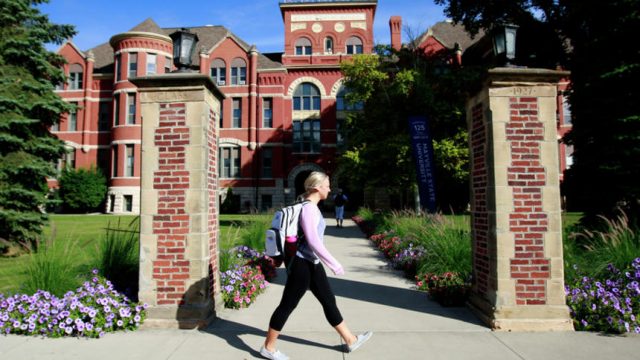North Dakota’s Constitution Must Be Amended So We Have the Flexibility to Face the Future of Higher Education

Hailey Vold, a senior at Mayville State, walks to class recently past Old Main. photo by Eric Hylden/Grand Forks Herald
Like it or not, the way Americans access higher education has changed. It will continue to change. Old models of delivering that education need to change with it.
Which is why lawmakers should pass HCR3016, introduced by Rep. Rick Becker (R-Bismarck), which would remove from the state constitution mandates for the names and locations of most of the state’s public institutions of higher education.
You can read the full bill below. It amends the state constitution to remove mention of eight institutions of higher education – the state operates 11 institutions in total, though three of them aren’t mentioned – leaving behind only this language: “The state board of higher education shall administer the state institutions of higher education.”
[mks_pullquote align=”right” width=”300″ size=”24″ bg_color=”#ffffff” txt_color=”#000000″]While many in charge of running our universities still believe we’re living in the good old days, when campus expansion and indiscriminate enrollment growth were the objectives, the public’s tolerance for lengthy and expensive matriculation on a physical campus is growing strained.[/mks_pullquote]
If lawmakers approve the resolution it would go to a vote of the people.
This is some tough medicine. The politics of higher education in North Dakota are built on parochialism. The reason the location of eight institutions (not to mention certain other state facilities like a school for the deaf and the mental hospital) are mandated in the constitution is because the lawmakers were doling out state jobs to themselves. Everyone wanted a university or a hospital or some other facility in their districts to bring in jobs and commerce.
Today the resistance to removing the mandate for these institutions still centers on jobs and commerce. As if the profits and tax revenues derived from selling pizza and beer to students were more important than organizing the university system around delivering the best academic outcomes for students.
It’s long been clear that operating 11 institutions of higher education in a state that graduates less than 10,000 students from high school every year was an extravagantly inefficient status quo. We should have long ago closed down some of these institutions, and re-focused those resources on the schools which remain open.
But we are very quickly coming into a time when we no longer have the luxury of being able to tolerate that inefficiency. While many in charge of running our universities still believe we’re living in the good old days, when campus expansion and indiscriminate enrollment growth were the objectives, the public’s tolerance for lengthy and expensive matriculation on a physical campus is growing strained. With the economy changing faster than ever, most of today’s students will likely need to seek new education and credentialing during their careers.
No longer can they afford to sink tens or hundreds of thousands of dollars into obtaining a degree at the dawn of adulthood. They need to have the flexibility and resources to continue education throughout their lives.
Thankfully, technology is making that sort of flexibility possible, but it won’t be possible here in North Dakota if the parochialism embedded in our state constitution is allowed to survive. Our university system must be organized around delivering valuable knowledge to modern students, not the more pecuniary interests of politicians and business owners.
Becker’s resolution doesn’t close any institutions, but it makes their close possible. We need to have that possibility if we want to avoid our university system becoming an anachronism.
[scribd id=397741646 key=key-QMhfnPs5pkaNY6wk7XSB mode=scroll]




